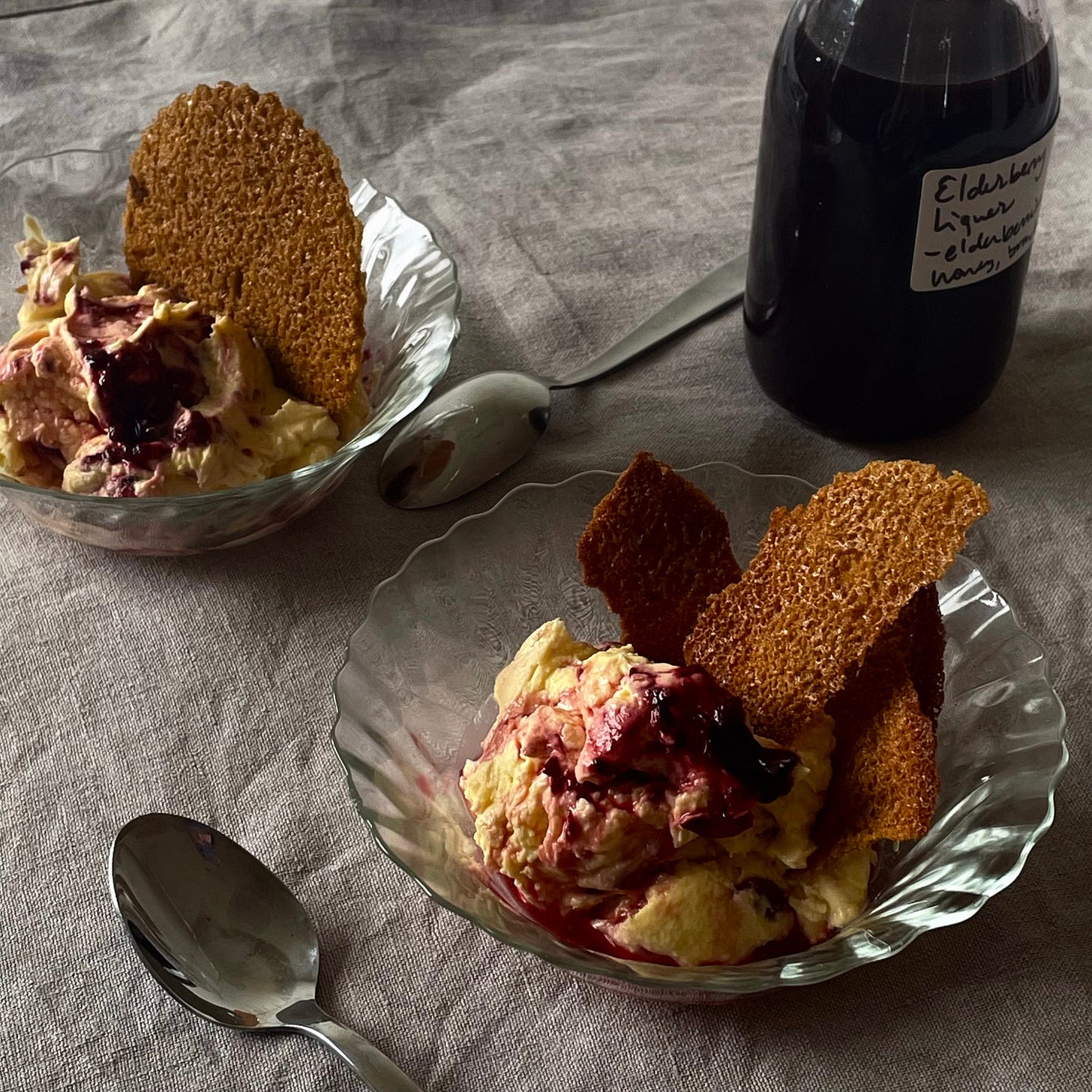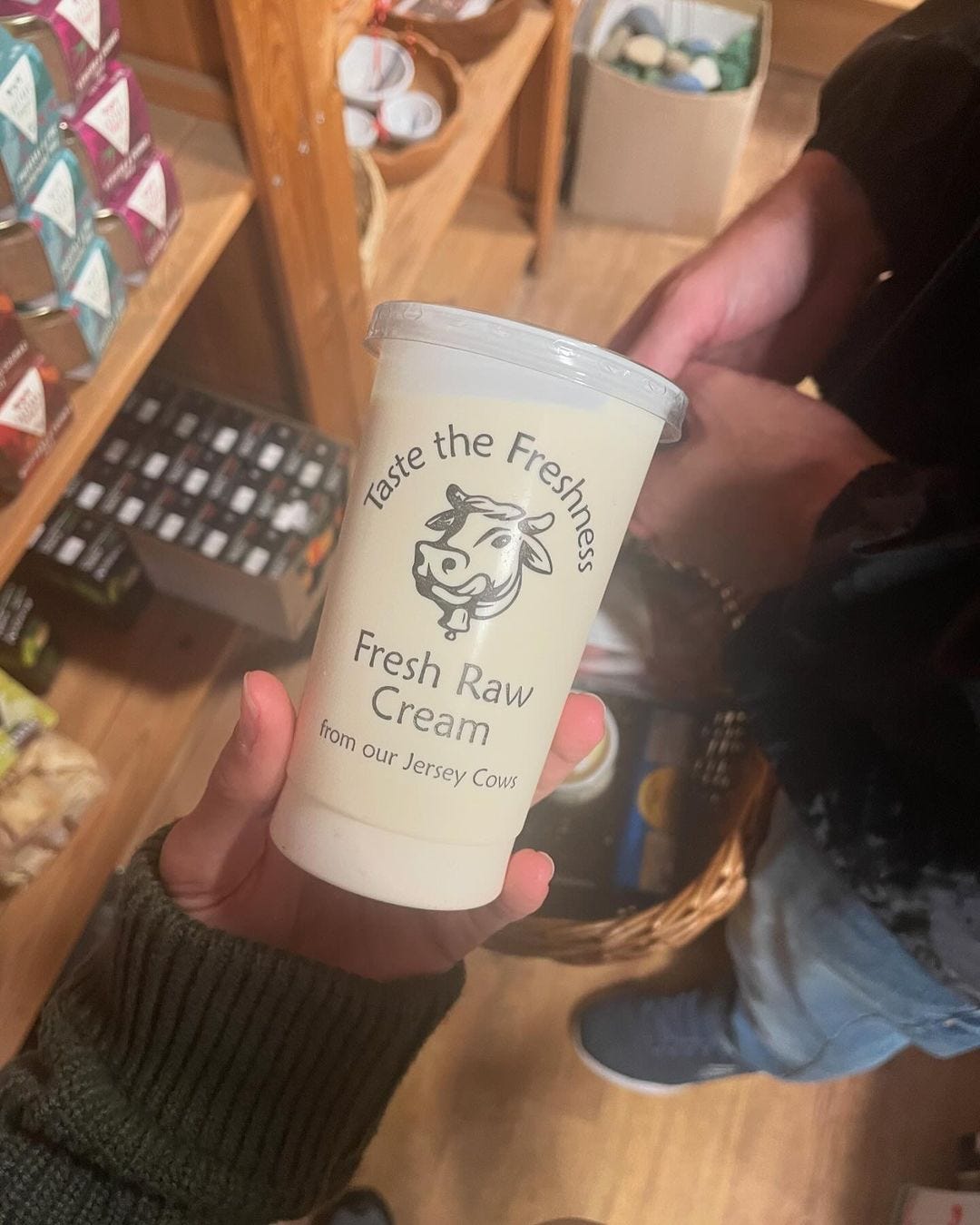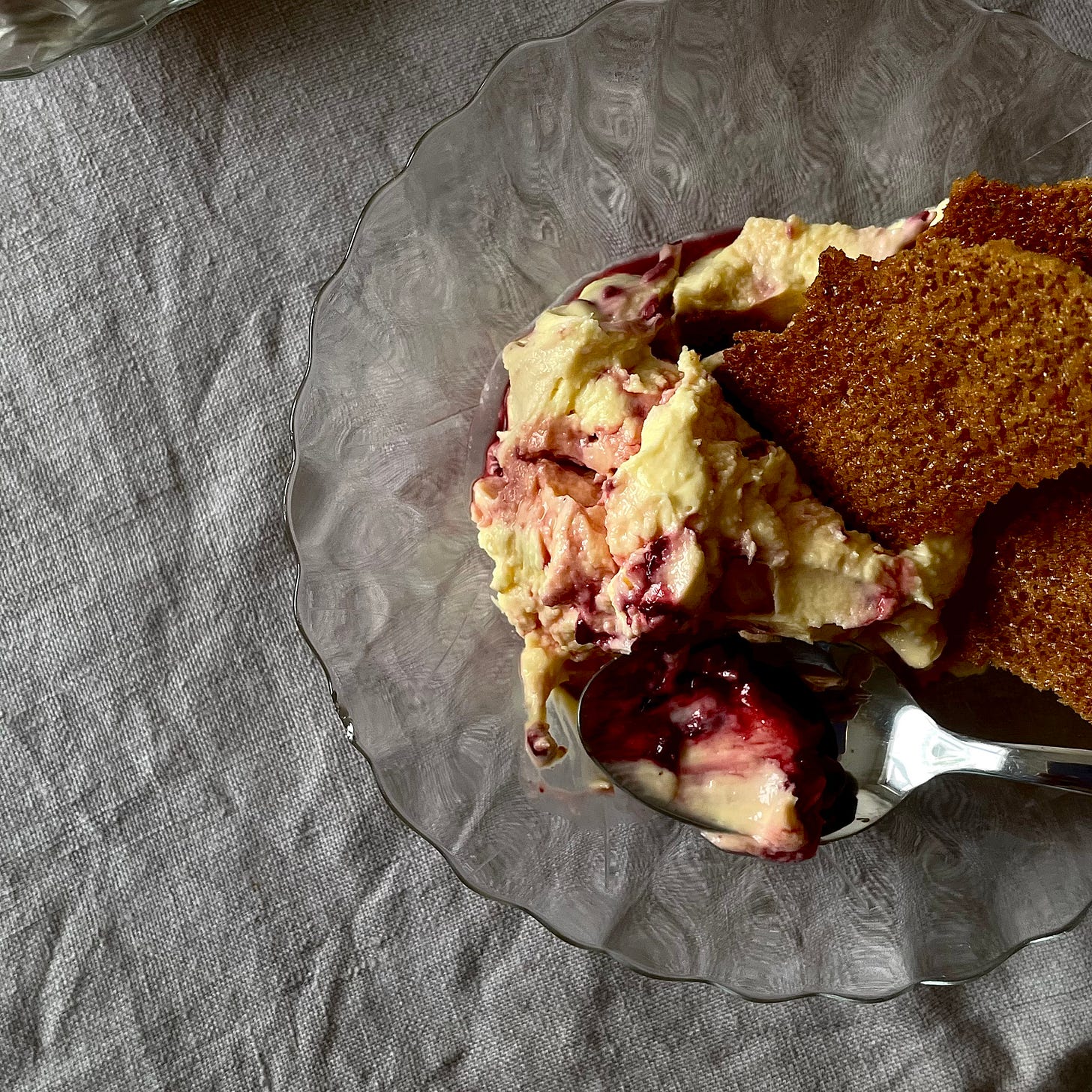Raw crème fraîche with rippled berries and almond tuiles
An ode to raw dairy, a note on detoxing, and a delightfully low-effort, high-value recipe for the most delicious crème fraîche you've ever had.
Crème fraîche is deceptively simple to make; it’s a cultured dairy product, meaning that it’s had a bit of something containing live bacterial cultures added to it in order to kick start the fermentation, rather than letting it ferment from scratch.
The formula here is thus very simple: just add a tablespoon of live yogurt to your cream, stir it in, and watch it culture and thicken up over the next couple of days. Add it to soups and stews and pasta dishes, in savoury or sweet recipes, and please make sure you spoon it straight into your mouth - it’s that delicious. I rippled some cooked blackberries through it and then drizzled some homemade elderberry liqueur over the top, and stuck an almond brown butter tuiles over the whole thing (recipe from Anna Higham’s The Last Bite, spread thinly on a flat tray).
Why the raw milk though?
A bit of context: I’m currently on a detox & root cause healing journey through Jade Mackie’s programme The Detox Academy, to address some aggressive eczema and strange allergies that developed the last 3 years. The premise is simple: help your body heal itself (as it’s meant to! Our bodies are not designed to turn on us and cause us pain - that’s quite literally the opposite of what it’s meant to do, which is to ensure our survival!) by unburdening - A.K.A. detoxifying - your insides from accumulated waste, chemicals, parasites, and heavy metals, through natural - and yes, very effective - protocols, as well as cutting out further toxins and sources of inflammation from your lifestyle. The journey takes time and requires a lot of conscious and sometimes difficult lifestyle choices, as well as a big mindset shift regarding medicine and healing, but I can say that I’ve never felt more empowered when it comes to my health and wellbeing. If you’d like to hear more about my experience on the program, please feel free to reach out! I’d love to share what I’ve learned!
As you might suspect, addressing gut health and dietary choices is a BIG part of changing that internal terrain. I’ll write about gut health soon, but for now I’ll say this: our gut plays a huge role in our overall health. It’s quite literally the centre of nutrient absorption, and also where waste (all the icky, toxic stuff our bodies don’t want) gets processed to be evacuated. And, it’s home to trillions of essential bacteria who have a huge impact on our health, and not just our digestive health - these critters perform functions for us (such as vitamin B12 production) that would literally take us years of evolution before we could develop the abilities ourselves. Suffice it to say, if something happens to disrupt gut health, you’ll start to see all sorts of issues cropping up, from allergies to intolerances to chronic diseases - even impacts on mental health. The importance of gut health cannot be overstated.
What you feed your gut, then, matters A LOT.
Rather inconveniently (for us consumers), the majority of the food found in supermarkets globally are not only devoid of nutrients but also full of all sorts of additives and chemicals, causing all kinds of inflammation. And dairy products are a top offender.
Pasteurised dairy products, that is. They’re one of the most allergenic foods today…think about how many people you know who’ve been diagnosed as lactose-intolerant, taking enzymes whenever they eat something with dairy to help their bodies digest it! It’s not surprising when you think about the processing dairy undergoes, which seriously strips it of any nutritional value. Heat-treating dairy products kills off microorganisms to make these products “safer”, seriously diminishing vitamin, mineral, protein, and enzyme content along the way. And often, those very same vitamins that get destroyed during processing are replaced with synthetic versions that get added back in afterwards (“fortification” it’s called!). The same thing happens to the conventional white flour you get today, milled from nutrient-devoid monocrop wheat that’s primarily composed of gluten, a highly inflammatory agent. This too has essential minerals and vitamins added back in after it’s been hyper-processed!
Let’s just clarify something.
The term raw seems to be rather maligned in certain contexts. Labelling something as ‘raw’ generally indicates that it hasn’t been heat-treated or radiation-treated, two processes that kill off microbes. But microbes come in all shapes and forms, with some seriously beneficial ones (we really need them in our gut, as mentioned above!) as well as some totally harmful ones. Let’s go back to fermentation as a case study: the objective is to encourage the growth of good microorganisms, which when established, will naturally outcompete the bad ones. Contamination is also much less likely to occur when product quality is high, and when the processing conditions are safe and carefully monitored. If you want to reap the most nutritional benefits from a ferment, you want to consume it raw, full of its good bacteria, vitamins, and enzymes. Something that is raw is also alive, a concept I really like to drive home during my classes.
To recap: just because something is raw, it doesn’t mean it’s inherently chock-full of harmful microorganisms. In fact, there might be some really beneficial ones too. And using processes like pasteurisation mean you’re getting rid of all of them, good and bad.
Raw milk in its natural state is in fact incredibly nutritious - it’s high in naturally-occurring and beneficial minerals, vitamins, probiotics, and enzymes (and these enzymes in particular help our bodies digest it!). Many of those nutrients, like calcium, are present in bioavailable states, meaning that our bodies can absorb and utilise them as is without needing to convert and process it.
So why do we hear that raw milk is unsafe? It’s important to note that no food product can ever be completely safe from moulds or pathogens; we’re dealing with organic matter, after all! As mentioned above, quality plays a huge role in guaranteeing a product’s safety, as do the handling and processing practices. In a letter written by the Raw Milk Institute in the US in 2019, they write: “The CDC outbreak and illness data which is used to assert that raw milk is unsafe does not distinguish raw milk intended for pasteurization from raw milk that is carefully produced and intended for direct human consumption. The FDA has no standard for raw milk intended for human consumption. It has only the Pasteurized Milk Ordinance (PMO). It is known that raw milk intended for pasteurization often contains pathogens; studies have shown that up to 24% of this type of milk tests positive for pathogens [32].”
Yikes! I’ll take raw milk intended for consumption from a small, local farm, where the cows are happily grazing in plain sight, over the pasteurised, big-ag derived stuff ANY DAY! If the cows are healthy and the handling processes are safe, there is literally no reason for raw milk to be infected with the likes of e.coli, listeria, or salmonella, the most common bacteria causing food-borne diseases. And I’ll most certainly trust the ethical small farmer rather than the factory plant in those regards. For those wondering - I have not had any adverse reactions when consuming raw dairy, despite the allergies and sensitivities I’ve developed.
Doesn’t it just make a lot more sense to choose better quality, and to process less and preserve the naturally-occurring goodness whilst also conserving resources?
Raw cream it is for my crème fraîche. In the UK and certain states in the US you can only buy raw dairy directly from the producer, which is a big barrier to access. We found a farm in Hertfordshire that sells raw milk out of a dispensing machine for £1.50 a liter; you grab a 1lt or 2lt bottle, insert your cash, and watch the machine fill it up for you. It is without a shadow of a doubt the most delicious milk I’ve ever had. And it’s in high demand - the people want it! A long queue often forms on weekends; one Saturday afternoon, an argument broke out because a pair of men were draining the milk machine (we’re talking upwards of 20 bottles and counting), causing a big back-up of nearly thirty people behind them. A farm attendant had to be called in to firmly tell them that they’d had their share. Rumour has it they were selling it illegally to cafés…
If you can’t find raw dairy products, or if you’re still not convinced it’s good for you, then go for the stuff labeled organic, grass-fed, and pasture-raised. At least you’ll know it comes from healthy cows fed a decent and nutritious diet, and who haven’t been pumped full of hormones and antibiotics.
This crème fraîche recipe is perfectly adaptable to pasteurised cream, so no worries if that’s all you have. Just note that it might take a day or two more to thicken compared to the raw cream - I suspect the good bacteria naturally present in the raw cream help the fermentation along!
Crème Fraîche
Ingredients:
A tub of raw cream
1 tbsp of yogurt with live cultures
Instructions:
Transfer the cream into a glass jar.
Stir the yogurt into the cream, and place the lid on top but don’t fully seal it.
Let sit for 24 hours - the cream should thicken and get wonderfully tangy quite quickly. If you’re using pasteurised cream, this process may take up to 2 days.
That’s it! Use it in recipes, or let it stand on its own two feet topped with macerated fruit, a drizzle of honey or nut butter, or some delicious fruit liqueur.
Learn to ferment with me! Upcoming Courses:
Cultured Condiments with Forest & Flora
October 16th - 6-8pm The Lacy Nook, Walthamstow
November 3rd - 11-2pm Hornbeam Cafe, Walthamstow
November 10th - 11-2pm Hornbeam Cafe, Walthamstow








I am so grateful that I live on a farm and milk my own cows for fresh raw milk, cream, cheese and butter! I use clabber to make my cream fraiche. This is delicious! Have you heard of clabber? I use it for my cheese starter too.
Thanks for this. Creme fraiche is in my top ten and I’m obsessed with raw milk - wish the local farm hadn’t stopped their vending machine while they do some year-long maintenance.